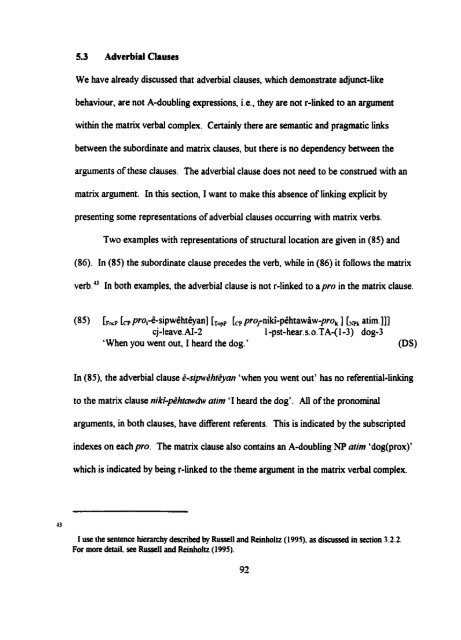Adverbial and Argument-Doubling Clauses in Cree - MSpace
Adverbial and Argument-Doubling Clauses in Cree - MSpace
Adverbial and Argument-Doubling Clauses in Cree - MSpace
Create successful ePaper yourself
Turn your PDF publications into a flip-book with our unique Google optimized e-Paper software.
5.3 <strong>Adverbial</strong> <strong>Clauses</strong><br />
We have already discussed that adverbial clauses, which demonstrate adjunct-like<br />
behaviour, are not A-doubl<strong>in</strong>g expressions, i-e., they are not r-l<strong>in</strong>ked to an argument<br />
with<strong>in</strong> the matrix verbal complex. Certa<strong>in</strong>ly there are semantic <strong>and</strong> pragmatic l<strong>in</strong>ks<br />
between the subord<strong>in</strong>ate <strong>and</strong> matrix clauses, but there is no dependency between the<br />
arguments of these clauses. The adverbial clause does not need to be construed with an<br />
matrix argument. In this section, 1 want to rnake this absence of l<strong>in</strong>k<strong>in</strong>g explicit by<br />
present<strong>in</strong>g some representations of adverbial clauses occurr<strong>in</strong>g with matrix verbs.<br />
Two examples with representations of stmctural location are given <strong>in</strong> (85) <strong>and</strong><br />
(86). In (85) the subord<strong>in</strong>ate clause precedes the verb, while <strong>in</strong> (86) it follows the matrix<br />
verb." In both examples, the adverbial clause is not r-l<strong>in</strong>ked to apro <strong>in</strong> the matrix clause.<br />
(85) [,[, pro,-6-sipwêhtêyan] [ , [, pro,-niki-pêhtawâw-prok ] [,atim.]]]<br />
cj-1eave.N-2<br />
1 -pst-hear. S. o. TA-(l-3) dog-3<br />
'When you went out, 1 heard the dog.'<br />
@SI<br />
In (85), the adverbial clause 6-szpShtêyan 'when you wem out' has no referential-l<strong>in</strong>k<strong>in</strong>g<br />
to the matrix clause niki-péhuwciw atim '1 heard the dog'. Al1 of the pronom<strong>in</strong>al<br />
arguments, <strong>in</strong> both clauses, have different referents. This is <strong>in</strong>dicated by the subscnpted<br />
<strong>in</strong>dexes on eachpro. The matrix clause dso conta<strong>in</strong>s an A-doubl<strong>in</strong>g NP atim 'dog(prox)'<br />
which is <strong>in</strong>dicated by be<strong>in</strong>g r-l<strong>in</strong>ked to the theme argument <strong>in</strong> the matrix verbal complex.<br />
I use the sentence hierarchy described by Russell <strong>and</strong> Re<strong>in</strong>holtz (1995)- as discussed <strong>in</strong> section 3.2.2.<br />
For more detail, see Russell <strong>and</strong> Re<strong>in</strong>holtz (1995).








![an unusual bacterial isolate from in partial fulf]lment for the ... - MSpace](https://img.yumpu.com/21942008/1/190x245/an-unusual-bacterial-isolate-from-in-partial-fulflment-for-the-mspace.jpg?quality=85)




![in partial fulfil]ment of the - MSpace - University of Manitoba](https://img.yumpu.com/21941988/1/190x245/in-partial-fulfilment-of-the-mspace-university-of-manitoba.jpg?quality=85)


